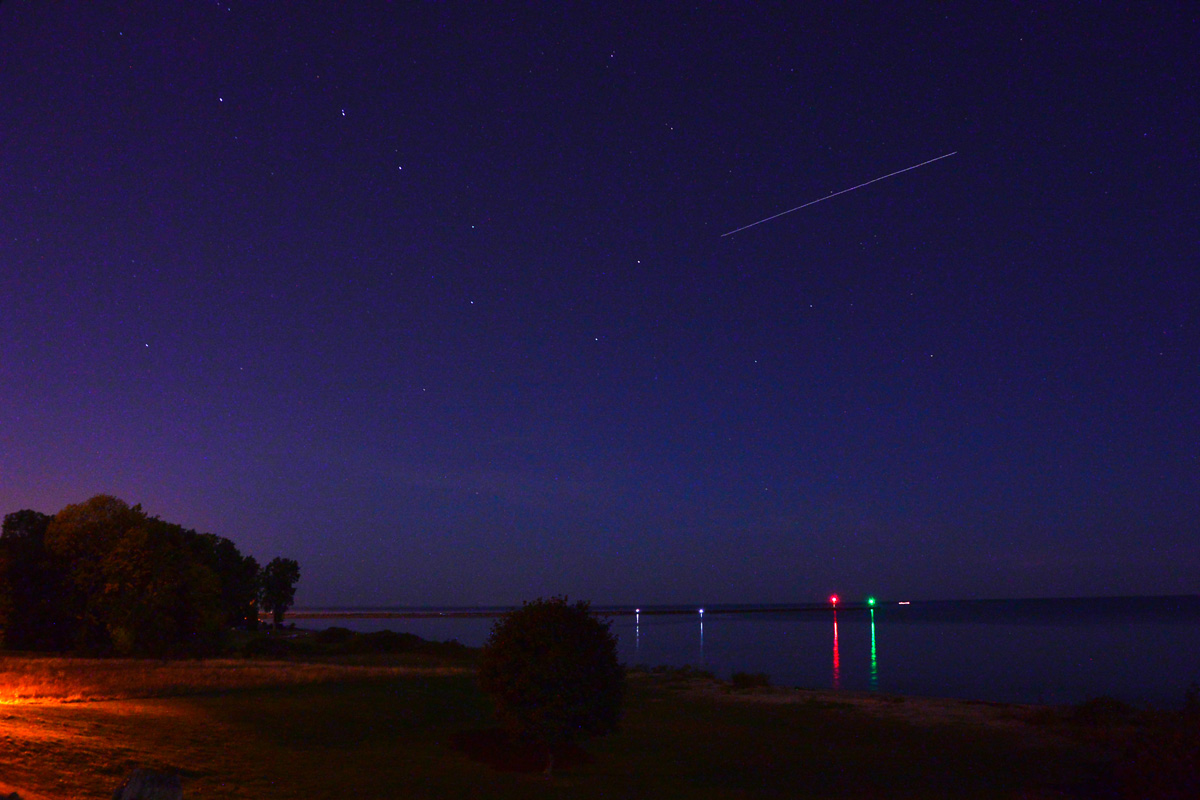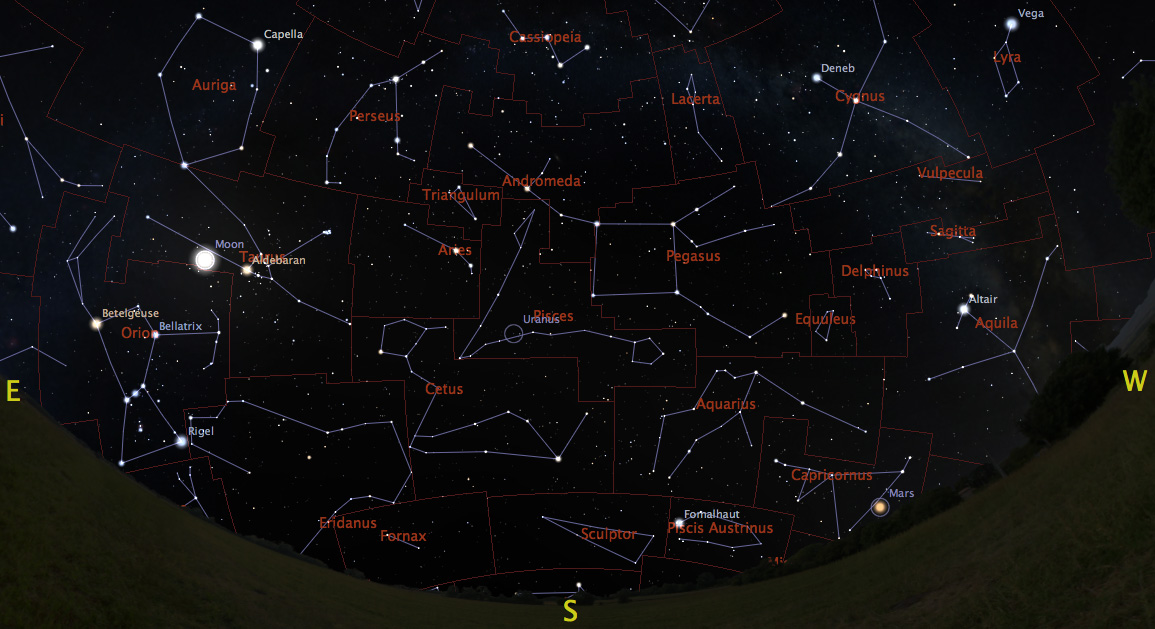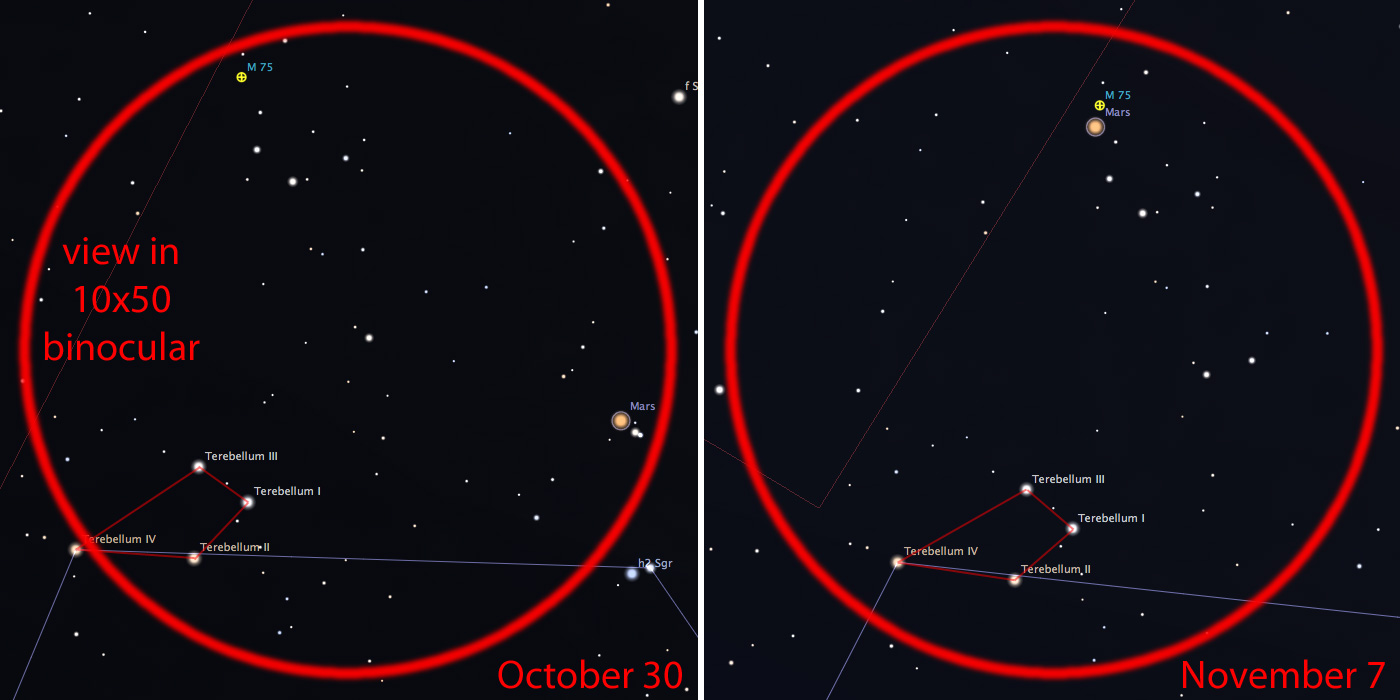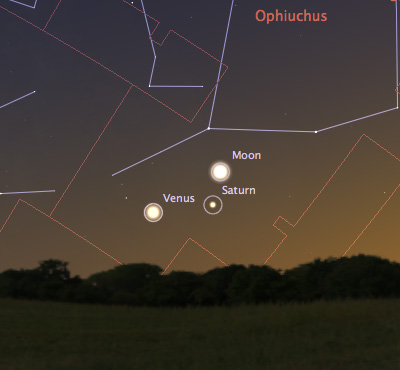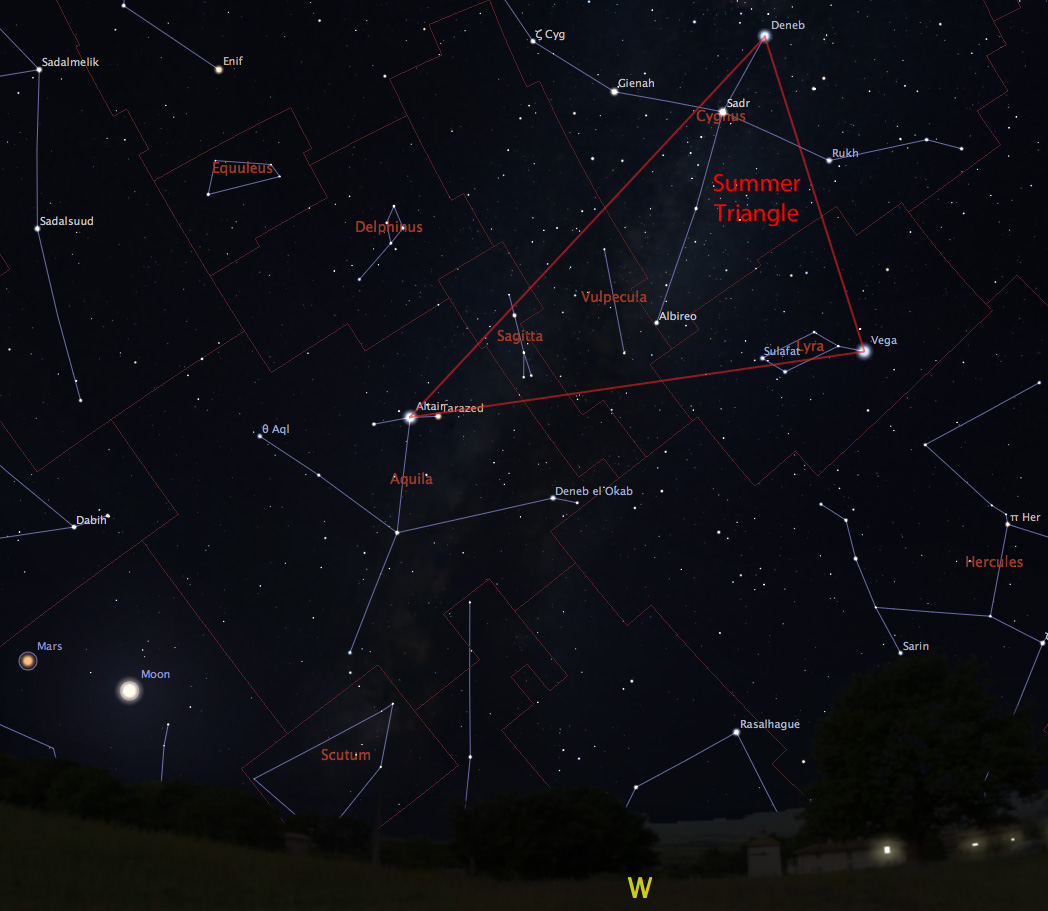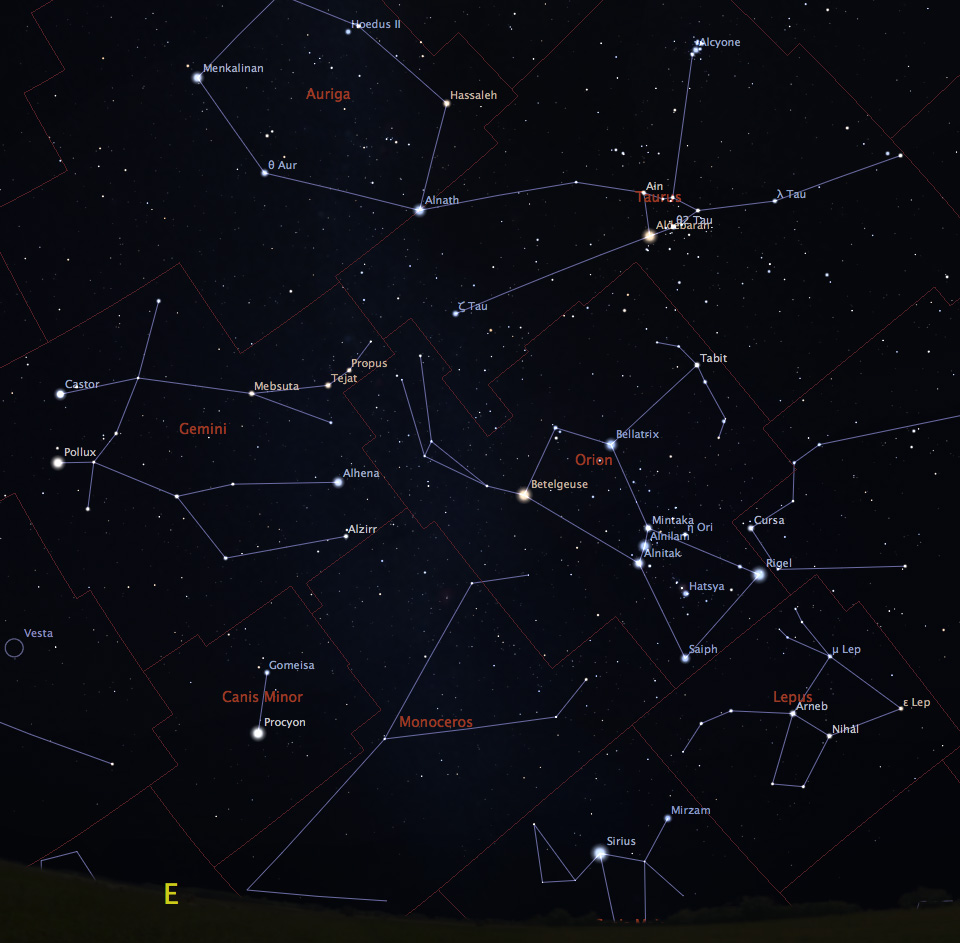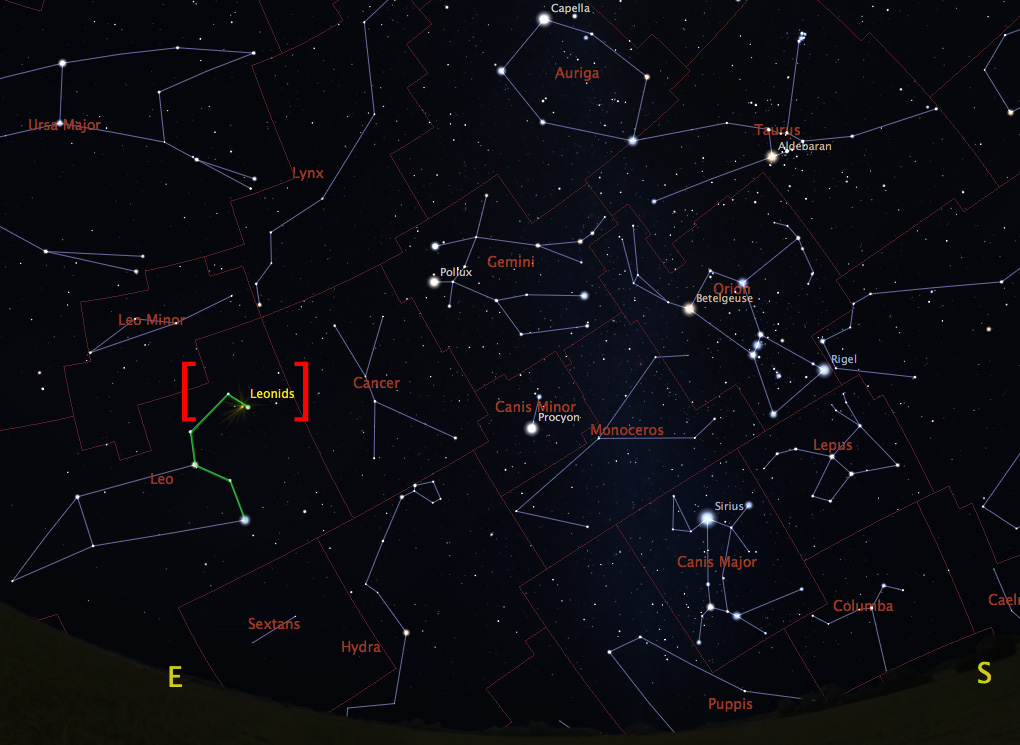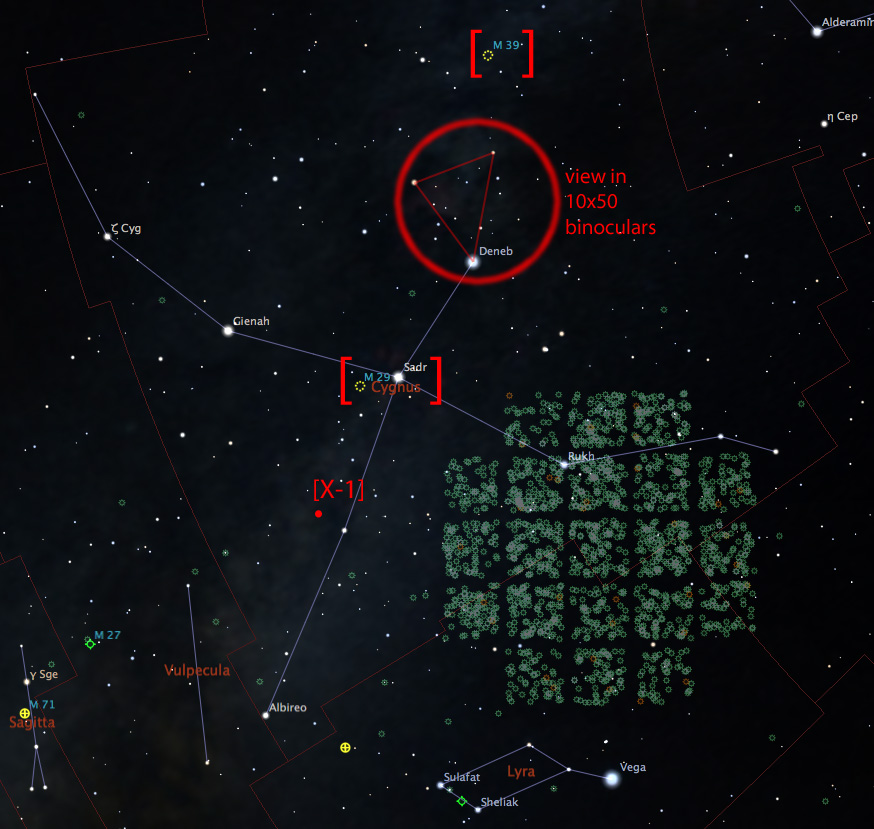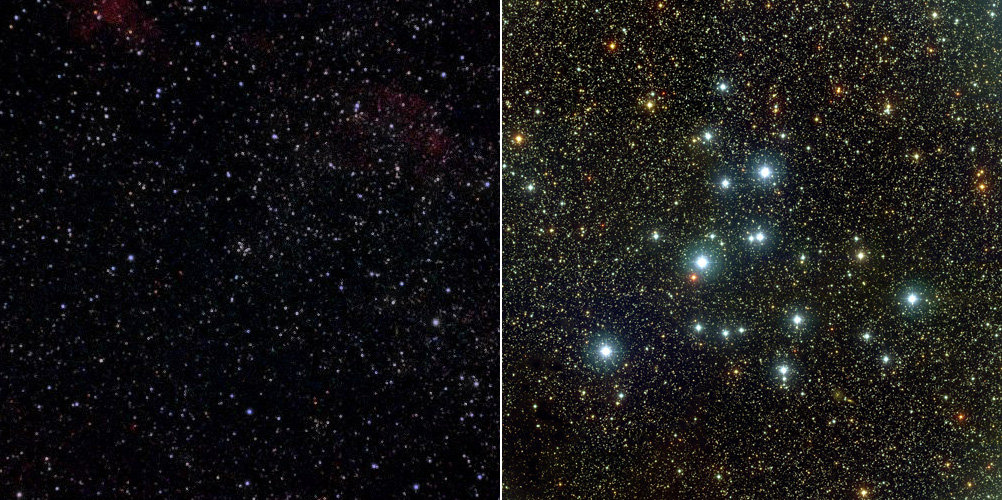Author's Note: The "Upstate New York Stargazing" series ran on the newyorkupstate.com and syracuse.com websites (and limited use in-print) from 2016 to 2018. For the full list of articles, see the Upstate New York Stargazing page.
Upstate NY Stargazing in November: The Leonid meteor shower takes the stage

Updated: Nov. 01, 2017, 12:20 p.m. | Published: Nov. 01, 2017, 11:20 a.m.
By Damian Allis | Contributing writer
Morning astronomy has its benefits! At night, you observe until you're too tired, or otherwise remember that your next day starts early. In the morning, the sun lets you know when you can't see anything else. Also on the plus side, evening observers get colder as they stay out longer. In the morning, you end up getting warmer the longer you're out.
To the morning astronomer, "what EDT giveth, EST taketh away." October and November are excellent for those who love observing and waking up early, as sunrise usually doesn't come until well into one's commute to work. The recent morning skies, filled with the brightest planets and excellent views of the constellation Orion and its neighbors, have been reason enough to throw a heavy coat on over pajamas to take the sights in. On Nov. 4, sunrise occurs at around 7:45 a.m., and a 5 a.m. riser can put it two good hours before twilight begins to consume most objects. On Nov. 5, sunrise occurs at around 6:45 a.m. With the drop of an auto-shifting smartphone, one full hour of observing goes away, leaving some to adapt to the time change or commit to that much earlier a bedtime.
Lectures And Observing Opportunities In Upstate/Central New York
New York has a number of astronomers, astronomy clubs, and observatories that host public sessions throughout the year. Announced sessions from several respondent NY astronomy organizations are provided for November so you can plan accordingly. As wind and cloud cover are always factors when observing, please check the provided contact information and/or email the groups a day-or-so before an announced session, as some groups will also schedule weather-alternate dates. Also use the contact info for directions and to check on any applicable event or parking fees.
Note that some clubs that have not yet may announce sessions for the Leonids later this month. Check their websites for updates as we get closer to the 18th.
Astronomy Events Calendar
| Organizer | Location | Event | Date | Time | Contact Info |
| Adirondack Public Observatory | Tupper Lake | Friday Night Observing | Nov. 3 | 7:00 PM | email, website |
| Adirondack Public Observatory | Tupper Lake | Friday Night Observing & Book Signing | Nov. 17 | 7:00 PM | email, website |
| Albany Area Amateur Astronomers & Dudley Observatory | Schenectady | Senior Science Day | Nov. 6 | 3:00 – 4:00 PM | email, website |
| Albany Area Amateur Astronomers & Dudley Observatory | Schenectady | niSci Science Festival | Nov. 8 – 12 | see schedule | email, website |
| Albany Area Amateur Astronomers & Dudley Observatory | Schenectady | AAAA Meeting | Nov. 16 | 7:30 – 9:00 PM | email, website |
| Albany Area Amateur Astronomers & Dudley Observatory | Schenectady | Octagon Barn Star Party | Nov. 17 | 7:30 – 9:00 PM | email, website |
| Albany Area Amateur Astronomers & Dudley Observatory | Schenectady | Night Sky Adventure | Nov. 21 | 7:00 – 8:30 PM | email, website |
| Astronomy Section, Rochester Academy of Science | Rochester | Member Meeting | Nov. 3 | 7:30 – 9:30 PM | email, website |
| Astronomy Section, Rochester Academy of Science | Rochester | Observing At The Strasenburgh | Nov. 4 | 7:30 – 9:30 PM | Jim S., 585-703-9876 |
| Astronomy Section, Rochester Academy of Science | Rochester | Observing At The Strasenburgh | Nov. 11 | 7:30 – 9:30 PM | Jim S., 585-703-9876 |
| Astronomy Section, Rochester Academy of Science | Rochester | Open House & Star Party | Nov. 12 | 12:00 – 4:00 PM | email, website |
| Astronomy Section, Rochester Academy of Science | Rochester | Observing At The Strasenburgh | Nov. 18 | 7:30 – 9:30 PM | Jim S., 585-703-9876 |
| Astronomy Section, Rochester Academy of Science | Rochester | Observing At The Strasenburgh | Nov. 25 | 7:30 – 9:30 PM | Jim S., 585-703-9876 |
| Baltimore Woods | Marcellus | Hello Winter Skies | Nov. 17 | 7:00 – 9:00 PM | email, website |
| Green Lakes State Park | Fayetteville | Telescope Workshop | Nov. 5 | 1:00 – 3:00 PM | 315-637-6111, website |
| Kopernik Observatory & Science Center | Vestal | KAS Monthly Meeting | Nov. 1 | 7:00 – 9:00 PM | email, website |
| Kopernik Observatory & Science Center | Vestal | Friday Night Lecture & Observing | Nov. 3 | 7:00 – 9:00 PM | email, website |
| Kopernik Observatory & Science Center | Vestal | Friday Night Lecture & Observing | Nov. 10 | see event link | email, website |
| Kopernik Observatory & Science Center | Vestal | Friday Night Lecture & Observing | Nov. 17 | 7:00 – 9:00 PM | email, website |
| Kopernik Observatory & Science Center | Vestal | Leonids Session | Nov. 18 | 8:00 PM – 1:00 AM | email, website |
| Kopernik Observatory & Science Center | Vestal | Friday Night Lecture & Observing | Nov. 24 | 7:00 – 9:00 PM | email, website |
| Mohawk Valley Astronomical Society | Waterville | Meeting | Nov. 8 | 7:30 – 9:00 PM | email, website |
| Mohawk Valley Astronomical Society | Waterville | Public Star Gazing | Nov. 11 | 7:30 – 10:00 PM | email, website |
| Syracuse Astronomical Society | Syracuse | Lecture @ OCC | Nov. 10 | 7:00 – 9:00 PM | email, website |
| Syracuse Astronomical Society | Syracuse | Scope Clinic @ Jamesville Library | Nov. 11 | 10:30 AM – 12:00 PM | email, website |
Lunar Phases
| Full Moon | Third Quarter | New Moon | First Quarter |
| Nov. 4, 1:22 a.m. | Nov. 10, 4:36 p.m. | Nov. 18, 7:32 a.m. | Nov. 26, 1:02 a.m. |
The Moon's increasing brightness as Full Moon approaches washes out fainter stars, random meteors, and other celestial objects – this is bad for most observing, but excellent for new observers, as only the brightest stars (those that mark the major constellations) and planets remain visible for your easy identification. If you've never tried it, the Moon is a wonderful binocular object. The labeled image identifies features easily found with low-power binoculars.

Observing Guides
Items and events listed below assume you're outside and observing most anywhere in New York state. The longer you're outside and away from indoor or bright lights, the better your dark adaption will be. If you have to use your smartphone, find a red light app or piece of red acetate, else set your brightness as low as possible.

Evening Skies: Two prominent shapes mark the eastern and western horizons for evening observers this month. To the east, the Bowtie of Orion, surrounded by a number of bright stars and prominent constellations. To the left, the Summer Triangle is still hanging on despite the seasonal change. In this geometry, the band of the Milky Way itself goes from east to west roughly through these two shapes. When you look north or south, you're looking out of the plane of the galaxy, where deep sky galaxy hunters set their sights away from all of the clutter in our own galaxy that obscures these distant views.

Morning Skies: This is a transitional month for planetary observers, with Venus setting earlier each night and Jupiter rising in time to take over "brightest planet" duties until well into next year. With Orion and its cohort all above the horizon before dawn, learning eight constellations at once is as easy as following some lines within Orion's bowtie asterism. Leonid hunters should star to look early for the backwards question mark between the Bowtie to the west and rising planets to the east.

Planetary Viewing
Mercury: The fleet-footed Mercury passes through the constellations Libra, Scorpius, Ophiuchus, and into Sagittarius this month. Mercury has returned to our early evening skies, but will be a difficult catch until after mid-November. Mercury sets soon after sunset until around Nov. 20 – you can find it with binoculars and a low horizon before, but be sure to wait until after sunset to begin your search. By the 20th, Mercury is high enough in the sky to be a bright early-evening target.
Starting on the 21st, Saturn and Mercury will just barely fit within the field of view of 10×50 binoculars, then will race toward one another for the rest of the month. The two will be at their closest on Dec. 6, but that pairing will only be visible for a very short time after sunset.

Venus: Venus is finishing its morning residency as the brightest pinpoint in the sky this month, returning as an evening target in February. Having tangled with Mars and the bright star Spica last month in the constellation Virgo, Venus now prepares for a very close approach with Jupiter in Libra. From the 7th to the 18th, Venus and Jupiter will fit within the field of view of 10×50 binoculars, albeit very close to sunrise when Jupiter clears the horizon earlier in the month. On the 13th, Jupiter and Venus will be exceptionally close to one another, with morning observers treated to both planets and all four of Jupiter's brightest moons. From bottom to top in your binoculars, the alignment will be Ganymede and Io below Jupiter, and Europa and Callisto above. The binocular pairing ends on the 18th, but not before a crescent moon and Venus will make a great binocular pairing on the 17th.

Mars: Mars spent October as the dim member of a bright pairing with Venus and will spend December being dulled by Jupiter when the two meet in Libra. November gives Mars a chance to be the only bright planet in Virgo. Mars still has competition for brightness – the bright star Spica shines a bit brighter than Mars. Starting on the 22nd, the two will fit within the field of view of 10×50 binoculars, then Mars will move closer until the morning of Dec. 2.
While giving Jupiter and Venus a look on the 15th, scan your binoculars a bit higher to see a sliver-of-a-crescent moon and Mars, which will just barely fit in a 10×50 field of view.
Jupiter: Jupiter makes its triumphant return to our skies as a morning object this month, replacing the brighter Venus in the process. Unlike the inner planet it is replacing, Jupiter will remain with us for many months to come, transitioning from an early morning object now into an early evening observing object this time next year. Besides the close pairings with Venus this month, Jupiter has its own meeting with a thin-sliver-of-a-moon on the 16th.
When the weather doesn't cooperate, the NASA Juno mission (tw,fb) continues to impress with hard science and beautiful images.
Saturn: Saturn continues its march towards the horizon this month, setting earlier each night. November will be the last month in 2017 you have to observe Saturn in the evening sky every night. It makes its appearance again at the very end of December as a morning target, joining Mercury, Mars, and Jupiter as the mornings progress into 2018. The 17th marks the transition of Saturn from the constellations Ophiuchus to Sagittarius, with the celebration on the 20th being lead by the sliver-of-a-crescent moon, which will pair nicely with Saturn in 10×50 binos. Saturn's month finishes with its pairing with Mercury as described above.
ISS And Other Bright Satellites
Satellite flyovers are commonplace, with several bright passes easily visible per hour in the nighttime sky, yet a thrill to new observers of all ages. Few flyovers compare in brightness or interest to the International Space Station. The flyovers of the football field-sized craft with its massive solar panel arrays and six current occupants can be predicted to within several seconds and take several minutes to complete.
The first half of the month contains several mornings of double-passes, although the adjusted clock means some of these will get washed out as dawn gives way to sunrise. The number of extremely bright fly-overs is a treat this month, perhaps NASA's unintentional way of coaxing people out despite the increasingly cold weather. With a 10-day break after the 16th, the end of the month will see the ISS return to evening skies, well-timed for those taking in early observing sessions.
ISS Flyovers
| Date | Brightness | Approx. Start | Start Direct. | Approx. End | End Direct. |
| 11/1 | moderately | 5:24 AM | SE | 5:26 AM | E |
| 11/1 | extremely | 6:56 AM | W/SW | 7:03 AM | NE |
| 11/2 | extremely | 6:06 AM | W/SW | 6:10 AM | NE |
| 11/3 | moderately | 5:17 AM | E/NE | 5:18 AM | E/NE |
| 11/3 | very | 6:49 AM | W/NW | 6:54 AM | NE |
| 11/4 | extremely | 5:59 AM | N | 6:02 AM | NE |
| 11/5 | very | 6:42 AM | NW | 6:46 AM | NE |
| 11/8 | moderately | 5:43 AM | N/NE | 5:45 AM | NE |
| 11/8 | moderately | 7:17 AM | NW | 7:22 AM | E/NE |
| 11/9 | moderately | 6:26 AM | N/NW | 6:29 AM | NE |
| 11/10 | moderately | 5:35 AM | N/NE | 5:36 AM | NE |
| 11/10 | very | 7:08 AM | NW | 7:14 AM | E/NE |
| 11/11 | very | 6:17 AM | N | 6:21 AM | E/NE |
| 11/12 | extremely | 7:00 AM | NW | 7:06 AM | E |
| 11/13 | very | 6:09 AM | N | 6:13 AM | E |
| 11/14 | extremely | 6:52 AM | NW | 6:57 AM | E/SE |
| 11/15 | extremely | 6:01 AM | NE | 6:04 AM | E/SE |
| 11/16 | extremely | 6:44 AM | W | 6:48 AM | S/SE |
| 11/26 | very | 7:24 PM | S/SW | 7:26 PM | S |
| 11/27 | moderately | 6:32 PM | S | 6:36 PM | E/SE |
| 11/27 | moderately | 8:08 PM | W/SW | 8:09 PM | W/SW |
| 11/28 | extremely | 7:15 PM | SW | 7:18 PM | SE |
| 11/29 | extremely | 6:22 PM | S/SW | 6:28 PM | E/NE |
| 11/29 | moderately | 7:59 PM | W | 8:00 PM | W/NW |
| 11/30 | extremely | 7:06 PM | W/SW | 7:10 PM | N/NE |
Predictions courtesy of heavens-above.com. Times later in the month are subject to shifts – for accurate daily predictions, visit spotthestation.nasa.gov.
Meteor Showers: Leonids – Active Nov. 15 to 20, Peaking Nov. 17.
Meteor showers are the result of the Earth passing through the debris field of a comet or asteroid. As these objects approach the warming sun in their long orbits, they leave tiny bits behind, usually no larger than grains of sand. The Earth plows through the swarm of these tiny particles at up-to 12 miles-per-second. High in the upper atmosphere, these particles burn up due to friction and ionize the air around them, producing the long light trails we see. We can predict the peak observing nights for a meteor shower because we know when and where in Earth's orbit we'll pass through the same part of the Solar System – this yearly periodicity is what let us identity and name meteor showers well before we ever had evidence of what caused them.
The name of each meteor shower is based on the constellation from which the shooting stars appear to radiate – a position in the sky we call the radiant. In the case of the Leonids, the meteor shower radiant appears to be just within Leo's mane, which rises from the east after midnight this month. The meteor shower itself is provided to us by Comet 55P/Tempel-Tuttle, whose 33-year orbit will return it to the inner solar system in 2031.

How to observe: The Leonids can be impressive and impressively bright, with up-to 20 meteors per hour expected this year. This shower will be improved by the lack of a Moon in the nighttime sky during the peak. To optimize your experience, lie flat on the ground with your feet pointed towards Leo and your head elevated – meteors will then appear to fly right over and around you.
Those interested in seeing a full list should check out the American Meteor Society meteor shower calendar.
Learn A Constellation: The Circumpolar Constellations in Review

One of the great problems with getting started in amateur astronomy around here is the lack of reinforcement. The chances of having multiple clear nights in a row to see – then see again – something you just learned are seemingly few and far between. A great way to start your journey through the 40-or-so constellations you can easily see from New York each year is to find the six constellations you know will always be visible regardless of the time of year.
Circumpolar constellations are those that never set below the horizon from a given latitude. For New York, there are six that are always visible every night and all year long, and are in fact always in the sky day and night. The rather busy image for this section walks you through November 1st in 6-hour increments from upper left to lower right. In each is a blue circle of six constellations – Ursa Minor, Ursa Major, Camelopardalis, Cassiopeia, Cepheus, and Draco. The many neighboring constellations with yellow labels eventually disappear below the horizon at some point, and you can follow this daily disappearing-reappearing act in the four images.
The six within the blue circles are your perfect place to start, and have been the focus of the last several months in the UNY Stargazing series. More information about each can be found in the following links: Ursa Minor, Ursa Major, Camelopardalis, Cassiopeia, Cepheus, and Draco.
Dr. Damian Allis is the director of CNY Observers and a NASA Solar System Ambassador. If you know of any other NY astronomy events or clubs to promote, please contact the author.
Original Posts:
- https://www.newyorkupstate.com/outdoors/2017/11/upstate_ny_stargazing_in_november_the_leonid_meteor_shower_takes_the_stage.html
- https://www.syracuse.com/outdoors/2017/11/upstate_ny_stargazing_in_november_the_leonid_meteor_shower_takes_the_stage.html
Tags:
